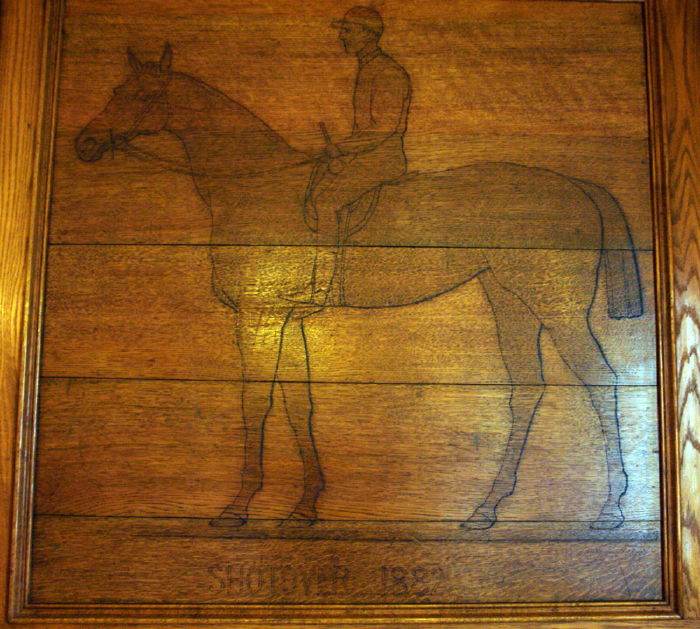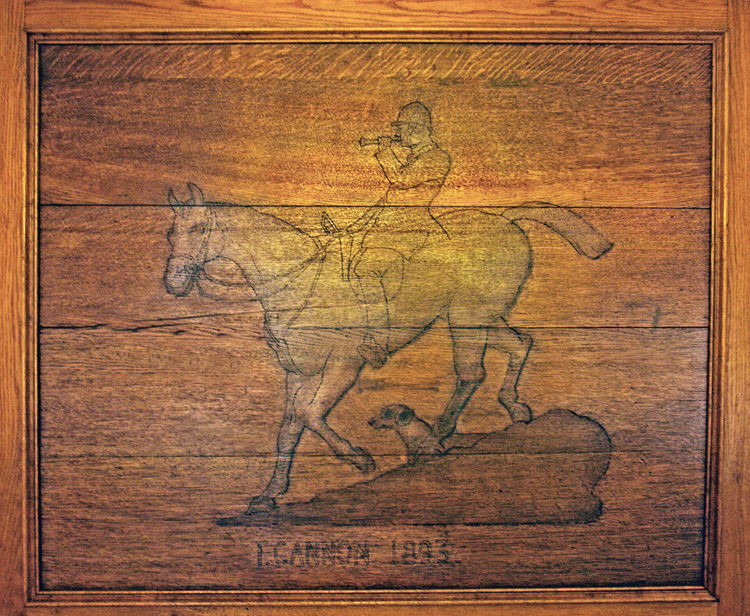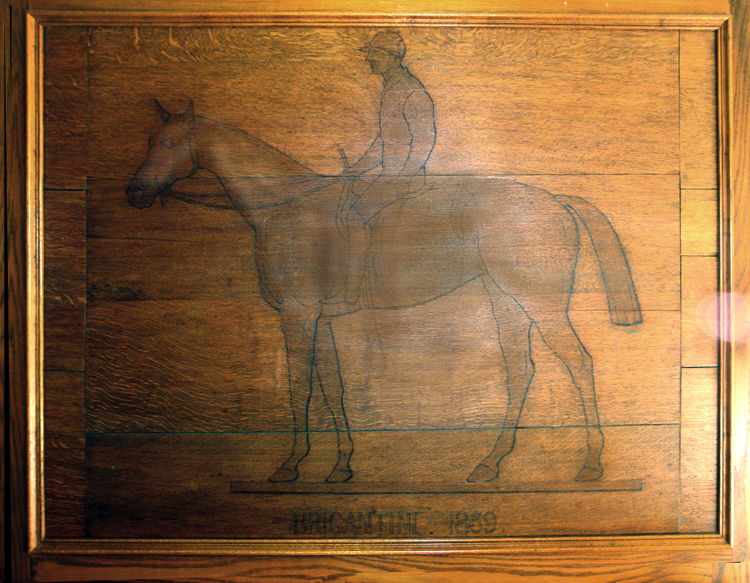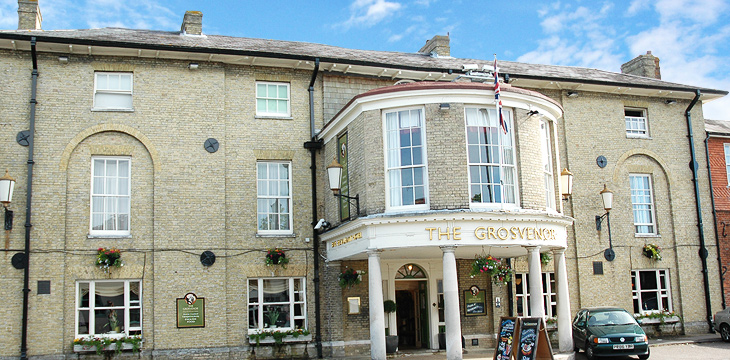E-Museum of Pyrographic ArtAntique Art Hall
|
| - Café Flambé - | - Portraits and Paintings - | - Decorative and Applied Art - |
| - Folk and Traditional Art - | - Antique Art - | - Special Hall - | - Sculpture - |
| - Children's Hall - | - Bookstore and Library - | - Tools and Techniques - |
 |
| Tom Cannon Riding Shotover Rendered in pyrography by Alice Mary Cannon, Tom Cannon's daughter Inscription, recto, reads: SHOTOVER 1882Pokerwork on framed wood panel, displayed at the Grosvenor Hotel Photograph by David Plunton |
 |
| Tom Cannon Riding His Favorite Hunter Danebury Rendered in pyrography by Alice Mary Cannon, Tom Cannon's daughter Inscription, recto, reads: T. CANNON 1893Pokerwork on framed wood panel, displayed at the Grosvenor Hotel Photograph by David Plunton |
Following, from David Plunton, is a little background on Danebury and the old Stockbridge racecourse (click on the link to see some nice old photographs of Stockbridge, as well):
"Danebury is the name of the nearby, 2,500-year-old, Iron Age hill fort that ... overlooks the site of the old Stockbridge racecourse.... From the top you can look out across the fields and still see the remains of the old grandstand, which is now covered in ivy. During bad weather, Tom Cannon used to train his horses in the lee of Danebury ring, the huge earthworks/ramparts that encircle the hill fort."
—David Plunton
 |
| Tom Cannon Riding Brigantine Rendered in pyrography by Alice Mary Cannon, Tom Cannon's daughter Inscription, recto, reads: BRIGANTINE 1869Pokerwork on framed wood panel, displayed at the Grosvenor Hotel Photograph by David Plunton |
The respective inscriptions on the recto of each panel in a series of ten elegant equestrian panels depicting Tom Cannon (1846–1917) mark the illustrious racing career of one of the foremost jockeys of his time. Three of those panels are displayed above.
Following is a short biography of Tom Cannon's career from the National Horseracing Museum in Suffolk:
"Well able to hold his own with the top riders of his day (the likes of George Fordham and Frederick Archer), Tom Cannon had his first mount—a faller—at the age of 14. Within the week he had steered home his first winner. The son of a Windsor horse-dealer, he was a beautiful horseman with the lightest of hands and fillies ran particularly well for him. Not many of that sex are successful in the 2000 Guineas or the Derby, but Pilgrimage and Shotover were two who did so.
Cannon was associated with the stables of John Day (whose daughter he married) and also the yards of John Porter and James Ryan. He later took up training, sending out a large mixed string from his father-in-law's stables. he tutored a number of successful jockeys, including his sons Kempton and Mornington. In time he became Clerk of the Course at Stockbridge and subsequently purchased an inn in the town before he died. Margaret, his daughter, became the grandmother of
Lester Piggott."
Both Tom Cannon's lineage and his wife's abound with prominent jockeys. Their great-grandson Lester Pigott, whose stellar career dominated the 1960's, is considered one of the world's greatest jockeys of all time.
Cannon was associated with the stables of John Day (whose daughter he married) and also the yards of John Porter and James Ryan. He later took up training, sending out a large mixed string from his father-in-law's stables. he tutored a number of successful jockeys, including his sons Kempton and Mornington. In time he became Clerk of the Course at Stockbridge and subsequently purchased an inn in the town before he died. Margaret, his daughter, became the grandmother of
Lester Piggott."
 |
| The Grosvenor Hotel Stockbridge, Hampshire, U.K. Tom Cannon acquired the old inn that became the elegant Grosvenor Hotel where he resided until his death. Today it is, among other claims to fame, the home of the Houghton Fishing Club (HFC) Dating from 1822, the HFC is deemed one of the 15 most exclusive clubs of Great Britain. Its small number of members hold exclusive rights to fish in a designated segment of the River Test, the most famous trout river in the world. They are also, according to David Plunton, the owners of the Tom Cannon equestrian panels. Photograph courtesy of The Grosvenor Hotel |
Dating from circa 1893, the Ten Equestrian Panels of Jockey Tom Cannon, are today in the restaurant of the famous Grosvenor Hotel in Stockbridge, Hampshire, U.K.
Please Note: Viewing the streaming images of the hotel and its interior at the restaurant and home pages, you will glimpse a few of the panels.
These are the panels cited in 2004 by Susan Millis in the closing notes of a 2-page interview for "Pyrograffiti" (at this link), where she explained that nine of the panels pictured him with his winning racehorses, and the tenth showed him riding his favorite hunter.
In the write-up at that hotel page is a little additional history, including that the hotel was once the private home of the famous jockey Tom Cannon.
UPDATE 16 August 2010: The E-Museum wishes to acknowledge Andrew Ager, who has provided the information that "The artist who did the Tom Cannon panels was his daughter, Alice Mary Cannon, who was born in Winchester on the 22 November 1866. She was the eldest child of Tom Cannon and Kate Day. She later went on to marry Mr Charles Compton Martin of Paulsgrove on the 6th December 1893; they had a very rare hunt wedding, then moved to South Africa the same year, where she shot a Boer in the war there. Around 30 years later she returned to England with her daughter Miss Vixon Compton Martin where they settled in Middlesex."
UPDATE 17 August 2010:
Thanks again to Andrew Ager, we have this excerpt from an article in The London Magazine dated August of 1902 that reveals that Alice Mary Cannon's panels were originally intended for the library of Tom Cannon's mansion at Garlogs:
"...The library is probably the only room of its kind in England. A wooden fresco runs round the walls, and on it Miss Cannon, who shines as an artist, has executed in poker work remarkably good likenesses of some of the best horses ridden by her father—Shotover (Derby), Geheimness (Oaks), Busybody (Oaks), Ormonde, Ackworth, Pilgrimage, Isonomy, Robert the Devil (St. Leger), and Humewood."
In light of this additional documentation, Andrew draws the following conclusions:
"It seems likely, therefore, that [Alice Mary's equestrian panels] were moved when Tom Cannon sold his Garlogs estate in about 1908 and took up residence at his Grosvenor Hotel property."
"The date for their production would have been between 1888 when Tom purchased the Garlogs estate and December 1893 when Alice set sail for Africa. Tom retired in 1892 from racing; so it could be possible this was a present from Alice to her father upon his retirement to commemorate his career. Or maybe the poker work was started after 1888 and continued in the summer holidays when Alice may have finished nine of the panels by 1892 when Tom retired, and finally added the panel of her father with his favorite hunter in 1893."
Regarding the presentation of the panels at the Grosvenor, Andrew adds this note:
"At the Grosvenor, the panels were located originally under the dado rail on the wall and in close to the floor, but some years back they moved the panels above the central dado rail on the wall to avoid damage from the chairs; they have been in that location ever since."
Andrew Ager is the great nephew of Alice Mary Cannon. He has just finished compiling a book of the complete history of his illustrious family from the 1700's until the 1970's. Their fascinating and wonderful story has taken him ten years to research and write. We look forward to the announcement of its publication.
With gratitude for his generous offer to photograph these 19th Century panels of Tom Cannon, the E-Museum of Pyrographic Art acknowledges British collector of antique pyrography David Plunton, who, coincidentally is a former Ranger whose duties included oversight of Danebury.
If you have either any questions or any additional information to offer about the artist Alice Mary Cannon or these Tom Cannon equestrian panels, please e-mail the E-Museum Curator.
You are leaving the Alice Mary Cannon Salon of the
Tom Cannon Equestrian Panels.
You can return to the
Antique Hall
or visit one of the following:
Pyrographic Art Exhibit Halls:
Portraits and Paintings
Decorative and Applied Art
Sculpture
Traditional and Folk Art
Children's Pyrographic Art
Special Pyrographic Art
The Book Store and E-Museum Library
Pyrography Tools and Techniques
Your questions and comments are welcome and appreciated.
Please e-mail the E-Museum Curator
Back to E-Museum Entrance homepage
© 2009, 2010 Kathleen M. Garvey Menéndez, all rights reserved.
9 December 2009. Updated 25 January 2010. Updated 16, 17 August 2010. Last updated 18 August 2010.

